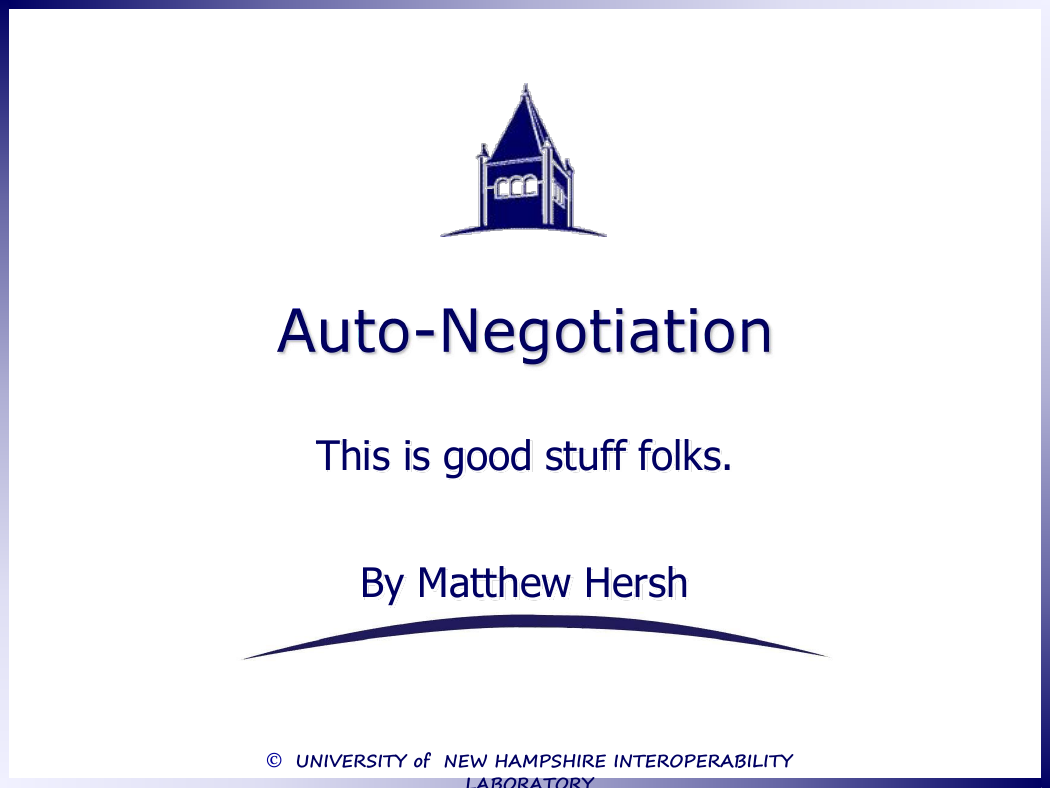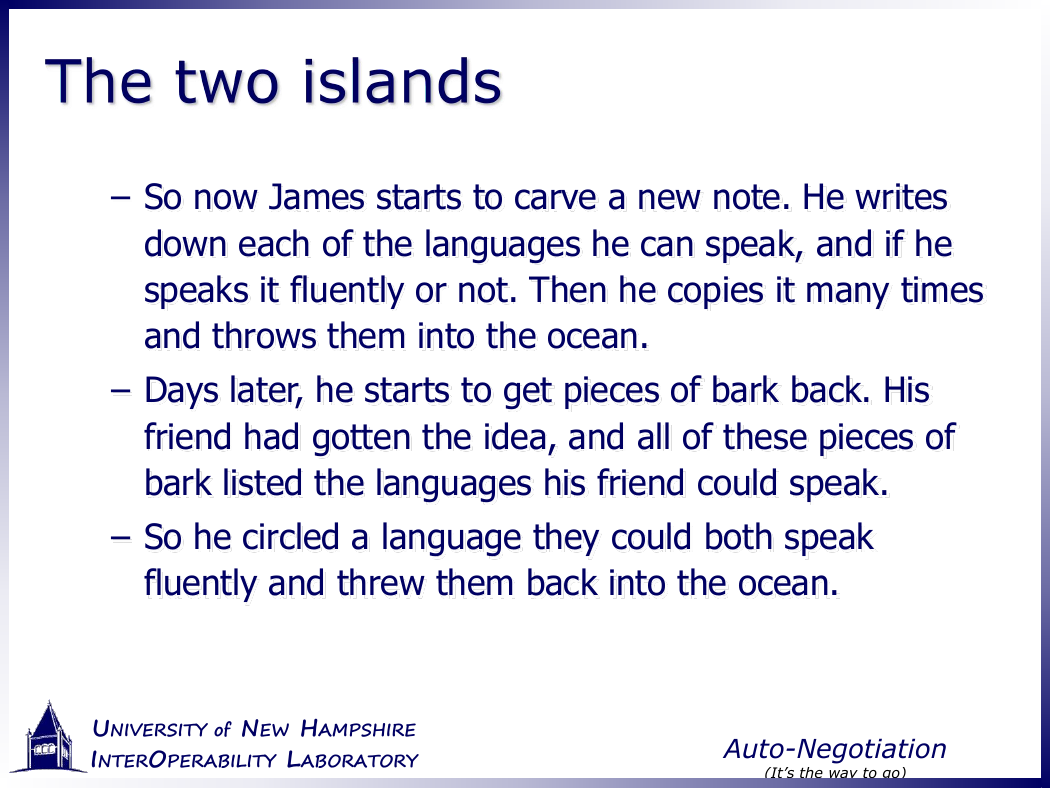This is good stuff folks.
By Matthew Hersh
© UNIVERSITY of NEW HAMPSHIRE INTEROPERABILITY
LABORATORY
�
• To portray the concept of Auto-Negotiation
(ANEG)
• To exhibit how devices choose the appropriate
link speed and duplex.
• To compare copper and fiber Auto-Negotiation
methods.
UNIVERSITY of NEW HAMPSHIRE
INTEROPERABILITY LABORATORY
Auto-Negotiation
(It’s the way to go)
�
• What is ANEG?
Some devices support more than one speed, i.e.
10BASE-T and 100BASE-TX. A device that
supports multiple speeds and/or duplex’s
needs a mechanism to decide what speed and
duplex to link at. ANEG is that mechanism.
UNIVERSITY of NEW HAMPSHIRE
INTEROPERABILITY LABORATORY
Auto-Negotiation
(It’s the way to go)
�
• Lets look at an example.
– Two men are stranded on two different islands. Each
one is very lonely and wants to talk to someone.
– So one day the first man “James” carves a note into a
piece of bark and throws it into the ocean.
– To his great surprise and excitement many days later a
piece of bark floats onto his beach, but when he picks
it up, the note he finds is in a different language.
UNIVERSITY of NEW HAMPSHIRE
INTEROPERABILITY LABORATORY
Auto-Negotiation
(It’s the way to go)
�
– James isn’t about to give up, so he sits down and tries
to figure out a way to communicate, first he decides
they need to speak the same language, but he doesn’t
know what language(s) his friend speaks.
– While he is thinking a second piece of bark floats onto
the beach. He looks at it and finds that is identical to
the first one, so he still can’t read it, but he realizes
that the man he is talking to is very smart.
– By throwing more than one piece of bark with the
same note, it increased that chance that he would
receive it
UNIVERSITY of NEW HAMPSHIRE
INTEROPERABILITY LABORATORY
Auto-Negotiation
(It’s the way to go)
�
– So now James starts to carve a new note. He writes
down each of the languages he can speak, and if he
speaks it fluently or not. Then he copies it many times
and throws them into the ocean.
– Days later, he starts to get pieces of bark back. His
friend had gotten the idea, and all of these pieces of
bark listed the languages his friend could speak.
– So he circled a language they could both speak
fluently and threw them back into the ocean.
UNIVERSITY of NEW HAMPSHIRE
INTEROPERABILITY LABORATORY
Auto-Negotiation
(It’s the way to go)
�
– The next piece of bark he received was a hello note
from his new friend “Chris” in a language that he could
read, and from then on they were great pen pals.
UNIVERSITY of NEW HAMPSHIRE
INTEROPERABILITY LABORATORY
Auto-Negotiation
(It’s the way to go)
�
• A device will always be sending stuff, even when
not connected to another device.
– If the device only supports one speed/duplex combo,
then the device will be transmitting link signaling
according with that speed (Does not support ANEG –
Legacy device).
– If the device supports more than one speed (or
duplex), then the device will be transmitting FLPs
(Does Support ANEG).
UNIVERSITY of NEW HAMPSHIRE
INTEROPERABILITY LABORATORY
Auto-Negotiation
(It’s the way to go)
�
















 2023年江西萍乡中考道德与法治真题及答案.doc
2023年江西萍乡中考道德与法治真题及答案.doc 2012年重庆南川中考生物真题及答案.doc
2012年重庆南川中考生物真题及答案.doc 2013年江西师范大学地理学综合及文艺理论基础考研真题.doc
2013年江西师范大学地理学综合及文艺理论基础考研真题.doc 2020年四川甘孜小升初语文真题及答案I卷.doc
2020年四川甘孜小升初语文真题及答案I卷.doc 2020年注册岩土工程师专业基础考试真题及答案.doc
2020年注册岩土工程师专业基础考试真题及答案.doc 2023-2024学年福建省厦门市九年级上学期数学月考试题及答案.doc
2023-2024学年福建省厦门市九年级上学期数学月考试题及答案.doc 2021-2022学年辽宁省沈阳市大东区九年级上学期语文期末试题及答案.doc
2021-2022学年辽宁省沈阳市大东区九年级上学期语文期末试题及答案.doc 2022-2023学年北京东城区初三第一学期物理期末试卷及答案.doc
2022-2023学年北京东城区初三第一学期物理期末试卷及答案.doc 2018上半年江西教师资格初中地理学科知识与教学能力真题及答案.doc
2018上半年江西教师资格初中地理学科知识与教学能力真题及答案.doc 2012年河北国家公务员申论考试真题及答案-省级.doc
2012年河北国家公务员申论考试真题及答案-省级.doc 2020-2021学年江苏省扬州市江都区邵樊片九年级上学期数学第一次质量检测试题及答案.doc
2020-2021学年江苏省扬州市江都区邵樊片九年级上学期数学第一次质量检测试题及答案.doc 2022下半年黑龙江教师资格证中学综合素质真题及答案.doc
2022下半年黑龙江教师资格证中学综合素质真题及答案.doc